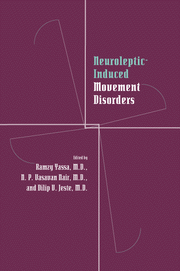Book contents
- Frontmatter
- Contents
- Contributors
- Preface
- Part I Historical perspective
- Part II Clinical aspects of tardive dyskinesia
- Part III Mechanisms underlying tardive dyskinesia
- 11 Neurochemistry of the basal ganglia
- 12 A reanalysis of the dopamine theory of tardive dyskinesia: the hypothesis of dopamine D1/D2 imbalance
- 13 Tardive dyskinesia and phenylalanine metabolism: risk-factor studies
- 14 Neuroendocrinological studies of tardive dyskinesia
- 15 Cognitive deficits and tardive dyskinesia
- 16 Studies of tardive dyskinesia using computed tomography and magnetic-resonance imaging
- 17 Rodent and other animal models of tardive dyskinesia during long-term neuroleptic-drug administration: controversies and implications for the clinical syndrome
- Part IV Measurement of tardive dyskinesia
- Part V Tardive dyskinesia in different populations
- Part VI Other neuroleptic-induced movement disorders
- Part VII Treatment of tardive dyskinesia
- Index
14 - Neuroendocrinological studies of tardive dyskinesia
from Part III - Mechanisms underlying tardive dyskinesia
Published online by Cambridge University Press: 09 October 2009
- Frontmatter
- Contents
- Contributors
- Preface
- Part I Historical perspective
- Part II Clinical aspects of tardive dyskinesia
- Part III Mechanisms underlying tardive dyskinesia
- 11 Neurochemistry of the basal ganglia
- 12 A reanalysis of the dopamine theory of tardive dyskinesia: the hypothesis of dopamine D1/D2 imbalance
- 13 Tardive dyskinesia and phenylalanine metabolism: risk-factor studies
- 14 Neuroendocrinological studies of tardive dyskinesia
- 15 Cognitive deficits and tardive dyskinesia
- 16 Studies of tardive dyskinesia using computed tomography and magnetic-resonance imaging
- 17 Rodent and other animal models of tardive dyskinesia during long-term neuroleptic-drug administration: controversies and implications for the clinical syndrome
- Part IV Measurement of tardive dyskinesia
- Part V Tardive dyskinesia in different populations
- Part VI Other neuroleptic-induced movement disorders
- Part VII Treatment of tardive dyskinesia
- Index
Summary
Recent research supports the idea that tardive dyskinesia is an etiologically heterogeneous disorder, with multiple neurochemical abnormalities contributing to its pathophysiology. A neurotransmitter imbalance has been the most frequently suggested pathophysiological mechanism, referring mainly to dopaminergic hyperactivity, GABAergic deficiency, or serotonergic imbalance (Ebadi & Hama, 1988).
The dopamine-supersensitivity hypothesis has been shown to be inadequate as a unitary explanation (Fibiger & Lloyd, 1984; Stoessl, Dourish, & Iversen, 1989). Some current proposals suggest that dopamine-receptor supersensitization resulting from chronic blockade by neuroleptics may be the first step in the pathogenesis of tardive dyskinesia, followed by necessary processes (not yet identified) in other neurochemical systems (Cassady et al., 1992).
Involvement of the GABA system in the development of persistent dyskinesia accounts for some of the evidence unexplained by the hypothesis of dopamine-receptor supersensitivity (Scheel-Krüger, 1986; Thaker et al., 1989b). Recent studies have supported the idea of GABA neuronal hypofunction in the substantia nigra pars reticulata (Monteleone et al., 1988; Thaker et al., 1989b).
There is also evidence for a serotonergic abnormality in patients with tardive dyskinesia. Much of our information suggests an inhibitory role for serotonin (5-HT) on nigrostriatal dopaminergic functioning (Sandyk, 1989). It seems that, in contrast to classic neuroleptics, clozapine does not induce tardive dyskinesia, the reason being that it is a potent 5-HT2 antagonist, the role of which is to release tonic inhibition of dopaminergic transmission and prevent depolarization inactivation at the presynaptic dopaminergic neuron, as well as to prevent denervation supersensitivity at the postsynaptic dopaminergic neuron (Coward, 1992).
- Type
- Chapter
- Information
- Neuroleptic-induced Movement DisordersA Comprehensive Survey, pp. 175 - 195Publisher: Cambridge University PressPrint publication year: 1996

